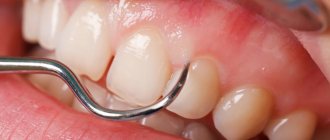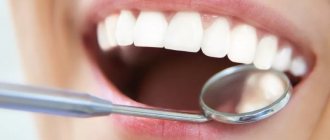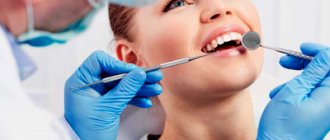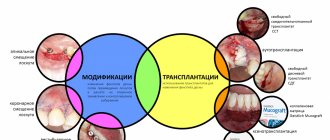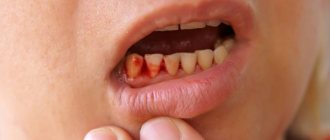An odontoparodontogram is a diagram - a drawing containing information about each dental unit. The drawing is intended to form a holistic picture of the current state of the dentofacial apparatus and identify various pathologies.
The technique was first put forward in 1953 by scientist and dentist V.Yu Kurdlyansky. The professor was of the opinion that in the normal condition of the teeth, only half of the tissues are used for full functioning, while the rest is in reserve.
The periodontium normally withstands a certain load until the threshold of pain sensitivity is overcome. These indicators form the basis of Kurdlyansky’s scheme.
Legend
Simplicity of graphical registration is ensured by the use of symbols. The periodontogram is compiled on the basis of data obtained after radiography and laboratory tests. Schematic designation of the graph:
- N – no pathologies detected;
- O – no bone formation;
- ¼ – 1 degree of atrophy;
- ½ – stage 2 defect;
- ¾ – 3rd stage.
In the second and third degrees of atrophy, a tooth located in soft tissues must be removed.
The value of periodontal endurance is conventionally designated by a coefficient - the ratio of load and pressure per unit.
With increasing atrophy and increased mobility of dental elements, the coefficient of resistance to stress decreases. The values of reserve tooth tissues vary depending on the degree of periodontal damage.
Odontoperiodontogram data
The method is based on the fact that the periodontium has a certain endurance, which decreases when it is destroyed. Previously, a gnathodynamometer was used to determine endurance. With its help, pressure was applied to the tooth until painful sensations appeared. In modern periodontology, computer examination is used to obtain accurate data. To simplify calculations in the ondontoparodontogram according to Kurlyandsky, coefficients defined for each tooth are used.
Data obtained during a clinical examination of the depth of the periodontal pocket and periodontal endurance are entered into the odontoperiodontogram table according to Kurlyandsky. Based on these data, the coefficient is calculated and the reserve and degree of functional deficiency of the tooth are identified.
Requirements for filling
Kurdlyansky's drawing is designed in the form of a table of cells with five parallel rows. The central row indicates the numbering of the teeth. The second line from the top displays the condition of the HF periodontium. The top line contains information about the HF reference apparatus.
The bottom lines containing data on the structure of the periodontium and elements of the LF are filled in identically. Information is entered into the table sequentially, starting from the lower jaw (right - left) and moving to the upper jaw (left - right).
After entering information about each tooth, the jaw indicators are summed up. Having received the total data, the value of the power ratios of the dentition below and above is determined.
Using the force ratio coefficient, the specialist identifies dominant groups of units and weak areas.
Based on the information in the drawing, the need to equalize the power relationship of the dentition or individual groups through orthopedic treatment is determined.
Evaluation Features
To simplify the graphical recording of information, all data has symbols. A periodontogram is compiled during X-ray diagnostics and laboratory and clinical procedures. Schematic labeling of the graph:
- N – without pathologies;
- O – no bone formation;
- ¼ – 1 (initial) degree of atrophy;
- ½ – stage 2 pathology;
- ¾ – 3rd stage.
At the fourth degree of atrophy (or III, tending to IV), the tooth located in the soft tissues must be removed.
The endurance of dental periodontium is conventionally designated by a coefficient representing the ratio of load and pressure on the teeth.
With the increasing stage of atrophy and increasing tooth mobility, the coefficient of resistance to all kinds of stress decreases, in particular during eating. The reserve tissues present in each tooth change their indicators in accordance with the degree of periodontal damage.
Practical meaning
The scheme is used when selecting an individual orthopedic device. Prosthetic products come in various types: removable, fixed, bridge-like. The dentist selects the appropriate model depending on the condition of the units and the patient’s wishes.
A periodontogram is necessary to calculate individual elements requiring prosthetics. The endurance indicator of the tissues of the supporting dental apparatus affects the possibility of choosing a specific model.
For bridge prosthetics, the sum of the coefficients is equal (in units):
- 4.75 and above (chewing teeth);
- 3.5 (front group on LF);
- 3-3.5 (HF incisors).
Kurdlyansky's scheme demonstrates effectiveness in:
- determining the optimal length of the splinting structure;
- installation of the optimal number of support units for bridge prosthetics;
- determining the number of clasps for a removable model;
- selection of locking fixation for the structure.
Table of odontoperiodontogram according to Kurlyandsky: diagram, features and important nuances
This scheme was first introduced into dental practice by Dr. Kurlyandsky in 1953. According to the specialist, in a normal state, the periodontium uses half of its resource, and another 50% of the reserve allows it to withstand loads. Currently, odontoparodontogram is also in great demand among dentists. Based on the research, a table is compiled that contains data on periodontal endurance - the limit when a tooth can withstand pressure without accompanying pain. To make it more comfortable for the dentist to work, separate coefficients have been introduced for each dental unit.
The odontoperiodontogram table according to Kurlyandsky is compiled on the basis of the following types of information:
- laboratory research;
- radiography;
- functional testing;
- clinical periodontal studies
In total, the graph consists of five lines. The specialist makes records gradually, starting with the first tooth in the lower jaw and ending with the left one in this row. The upper jaw is examined according to the same principle - starting with the outer left tooth (wisdom), and ending with the right outer wisdom tooth.
The first row contains information about the condition of the periodontium of the upper jaw, and the second row contains data about the soft tissues of the upper jaw. The third line contains a formula with graphic designations of each tooth in Arabic numerals.
The drawing shows the following symbols:
- Sign O – missing tooth;
- Sign N – normal dental unit;
- More than ¾ - degree IV tissue atrophy;
- ¾ — tissue atrophy of the third degree is observed;
- ½ - second level atrophy;
- ¼ - atrophic processes of the first degree.
After the dentist has filled out the table, you can determine the exact number of healthy supporting teeth that are important for further jaw prosthetics. After summing up the periodontal endurance coefficients of supporting dental units, the dentist will be able to accurately select a prosthesis in this particular case.
The gradation of the sum of the coefficients looks like this:
- for the anterior teeth of the upper jaw - more than 3 units;
- for the front teeth of the lower jaw - at least 3.5 units;
- for chewing units of the lower jaw - more than 4.75 units.
Thus, an odontoperiodontogram is performed to compare the functionality of the teeth of the lower jaw with the resources of the teeth of the upper jaw. But based on the data obtained, it is possible to select an ideally suitable prosthesis design - a classic “bridge” or a removable one.
The scheme is also relevant if the patient suffers from periodontal disease, and this problem can interfere with the normal functioning of the prosthesis. Based on the odontoparodontogram data, the dentist determines the length of the splinting structure and the exact number of supporting teeth. The data is transmitted to a dental laboratory, where a specialist produces a product for this specific request.
It is important! An odontoparodontogram allows you to determine the exact number of clasps for a removable structure, as well as select any other clasp for the prosthetic structure.
Features of gnathodynamometry
As part of the odontoparodontogram, gnathodynamometry is performed - determining the strength of the masticatory muscles, the level of endurance of the supporting teeth when clenching the jaws using a special apparatus. These indicators are tested on a gnathodynamometer. At the moment the jaws are clenched, an indicator is recorded, which normally in an adult ranges from 15 to 35 kg in the area of the front teeth and from 45 to 75 kg in the area of the distant, chewing teeth. The level of endurance may vary, especially with gum disease (periodontal disease, periodontitis), or the absence of one or a number of teeth.
The main purpose of a properly performed odontoperiodontogram is to help the specialist make a thorough comparison of the functions of the teeth and gums of the lower jaw with the potential of the dental groups of the upper jaw. Based on the diagram data, it is possible to determine the optimal prosthesis design for a particular patient, the splinting system, and the number of supporting teeth.
How is the table filled out?
Data about each tooth and supporting part are entered into the diagram. This information is derived from:
- X-rays of the jaw and teeth;
- visual examination of the patient;
- laboratory and clinical tests;
- patient's medical history.
The data allows you to identify:
- type of prosthetics;
- length and features of the splinting system;
- if the study is not performed for the first time, its results help determine the dynamics of treatment.
The accuracy of determining the prosthetic method and the success of treatment depend on how accurately and correctly the diagram is filled out.
The table consists of the following main rows:
- N – means that no pathologies were found in this area;
- O – means that there is no bone formation in this area;
- more than ¾ - pathology of the highest degree (fourth);
- ¼ — tissue depletion of the 1st degree;
- ½ — atrophic changes of the 2nd degree;
- ¾ - pathology of the third degree out of four possible.
After filling out the schematic drawing, the specialist summarizes the results that characterize the condition of the lower and upper jaws, determining the power potential of the dentition.
Only a professional dentist with extensive experience in this field can correctly compile and decipher an odonto-periodontogram. The 100 Teeth network of clinics employs specialists who daily compile odonto-periodontogram tables and, based on them, recommend treatment to patients.
By filling out the table, a specialist can determine the exact number of supporting structures needed to install a bridge system.
Examples of coefficient sums for installing a bridge on a patient:
- at least 3 units. – for the frontal group of teeth in the upper jaw;
- not less than 3.5 units. – for the frontal teeth of the lower jaw;
- not less than 4.8 units. – for chewing, in the lower and upper jaws.
Filling rules
Odontoparodontogram according to Kurlyandsky is presented in the form of a table of cells with five parallel lines.
In the central row, the designation of each tooth is indicated using Arabic numbering. The second line from the top is the condition of the maxillary periodontium. The topmost line contains data on the supporting apparatus of the upper jaw.
The bottom lines with information about the condition of the periodontium and lower jaw teeth are filled in in the same way. All data is entered into the table sequentially. The recording begins with the lower jaw (from right to left) and ends with the upper jaw (from left to right).
Having filled out the drawing with information about the condition of all teeth, the indicators of both jaws are summed up. The total data is the determining value of the power relationships of the upper and lower dentitions.
The force ratio coefficient allows us to identify dominant groups of teeth and places most susceptible to injury and damage.
Based on graphic registration data, the need is established to equalize the force ratio of individual groups of teeth or a whole row using orthopedic intervention.
Initial table and real example of filling out an odonto-periodontogram:


